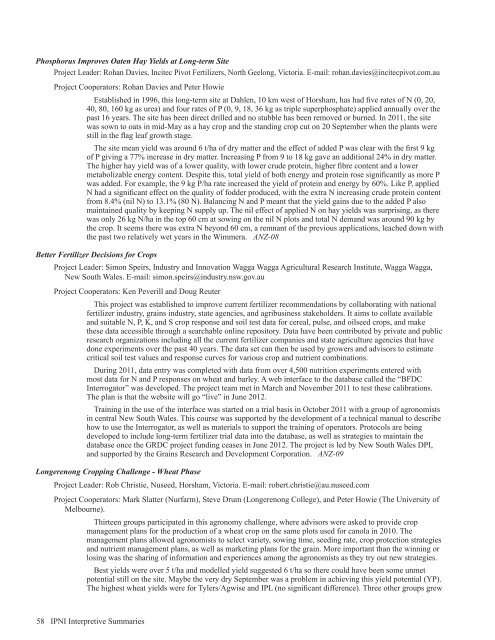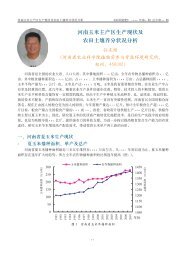Americas and Oceania Group - International Plant Nutrition Institute
Americas and Oceania Group - International Plant Nutrition Institute
Americas and Oceania Group - International Plant Nutrition Institute
Create successful ePaper yourself
Turn your PDF publications into a flip-book with our unique Google optimized e-Paper software.
Phosphorus Improves Oaten Hay Yields at Long-term Site<br />
Project Leader: Rohan Davies, Incitec Pivot Fertilizers, North Geelong, Victoria. E-mail: rohan.davies@incitecpivot.com.au<br />
Project Cooperators: Rohan Davies <strong>and</strong> Peter Howie<br />
Established in 1996, this long-term site at Dahlen, 10 km west of Horsham, has had five rates of N (0, 20,<br />
40, 80, 160 kg as urea) <strong>and</strong> four rates of P (0, 9, 18, 36 kg as triple superphosphate) applied annually over the<br />
past 16 years. The site has been direct drilled <strong>and</strong> no stubble has been removed or burned. In 2011, the site<br />
was sown to oats in mid-May as a hay crop <strong>and</strong> the st<strong>and</strong>ing crop cut on 20 September when the plants were<br />
still in the flag leaf growth stage.<br />
The site mean yield was around 6 t/ha of dry matter <strong>and</strong> the effect of added P was clear with the first 9 kg<br />
of P giving a 77% increase in dry matter. Increasing P from 9 to 18 kg gave an additional 24% in dry matter.<br />
The higher hay yield was of a lower quality, with lower crude protein, higher fibre content <strong>and</strong> a lower<br />
metabolizable energy content. Despite this, total yield of both energy <strong>and</strong> protein rose significantly as more P<br />
was added. For example, the 9 kg P/ha rate increased the yield of protein <strong>and</strong> energy by 60%. Like P, applied<br />
N had a significant effect on the quality of fodder produced, with the extra N increasing crude protein content<br />
from 8.4% (nil N) to 13.1% (80 N). Balancing N <strong>and</strong> P meant that the yield gains due to the added P also<br />
maintained quality by keeping N supply up. The nil effect of applied N on hay yields was surprising, as there<br />
was only 26 kg N/ha in the top 60 cm at sowing on the nil N plots <strong>and</strong> total N dem<strong>and</strong> was around 90 kg by<br />
the crop. It seems there was extra N beyond 60 cm, a remnant of the previous applications, leached down with<br />
the past two relatively wet years in the Wimmera. ANZ-08<br />
Better Fertilizer Decisions for Crops<br />
Project Leader: Simon Speirs, Industry <strong>and</strong> Innovation Wagga Wagga Agricultural Research <strong>Institute</strong>, Wagga Wagga,<br />
New South Wales. E-mail: simon.speirs@industry.nsw.gov.au<br />
Project Cooperators: Ken Peverill <strong>and</strong> Doug Reuter<br />
This project was established to improve current fertilizer recommendations by collaborating with national<br />
fertilizer industry, grains industry, state agencies, <strong>and</strong> agribusiness stakeholders. It aims to collate available<br />
<strong>and</strong> suitable N, P, K, <strong>and</strong> S crop response <strong>and</strong> soil test data for cereal, pulse, <strong>and</strong> oilseed crops, <strong>and</strong> make<br />
these data accessible through a searchable online repository. Data have been contributed by private <strong>and</strong> public<br />
research organizations including all the current fertilizer companies <strong>and</strong> state agriculture agencies that have<br />
done experiments over the past 40 years. The data set can then be used by growers <strong>and</strong> advisors to estimate<br />
critical soil test values <strong>and</strong> response curves for various crop <strong>and</strong> nutrient combinations.<br />
During 2011, data entry was completed with data from over 4,500 nutrition experiments entered with<br />
most data for N <strong>and</strong> P responses on wheat <strong>and</strong> barley. A web interface to the database called the “BFDC<br />
Interrogator” was developed. The project team met in March <strong>and</strong> November 2011 to test these calibrations.<br />
The plan is that the website will go “live” in June 2012.<br />
Training in the use of the interface was started on a trial basis in October 2011 with a group of agronomists<br />
in central New South Wales. This course was supported by the development of a technical manual to describe<br />
how to use the Interrogator, as well as materials to support the training of operators. Protocols are being<br />
developed to include long-term fertilizer trial data into the database, as well as strategies to maintain the<br />
database once the GRDC project funding ceases in June 2012. The project is led by New South Wales DPI,<br />
<strong>and</strong> supported by the Grains Research <strong>and</strong> Development Corporation. ANZ-09<br />
Longerenong Cropping Challenge - Wheat Phase<br />
Project Leader: Rob Christie, Nuseed, Horsham, Victoria. E-mail: robert.christie@au.nuseed.com<br />
Project Cooperators: Mark Slatter (Nurfarm), Steve Drum (Longerenong College), <strong>and</strong> Peter Howie (The University of<br />
Melbourne).<br />
Thirteen groups participated in this agronomy challenge, where advisors were asked to provide crop<br />
management plans for the production of a wheat crop on the same plots used for canola in 2010. The<br />
management plans allowed agronomists to select variety, sowing time, seeding rate, crop protection strategies<br />
<strong>and</strong> nutrient management plans, as well as marketing plans for the grain. More important than the winning or<br />
losing was the sharing of information <strong>and</strong> experiences among the agronomists as they try out new strategies.<br />
Best yields were over 5 t/ha <strong>and</strong> modelled yield suggested 6 t/ha so there could have been some unmet<br />
potential still on the site. Maybe the very dry September was a problem in achieving this yield potential (YP).<br />
The highest wheat yields were for Tylers/Agwise <strong>and</strong> IPL (no significant difference). Three other groups grew<br />
58 IPNI Interpretive Summaries

















